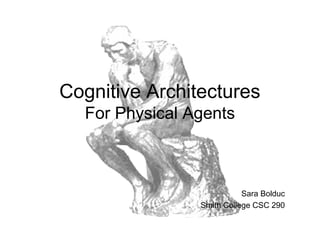
Cognitive Architectures for Physical Agents in 40 Characters
- 1. Cognitive Architectures For Physical Agents Sara Bolduc Smith College CSC 290
- 2. Overview • Background & Motivation • Example Cognitive Architectures • Capabilities • Properties • Evaluation Criteria • Open Issues
- 3. Background & Motivation • What is a cognitive architecture? • Why create a cognitive architecture? • Emerging architectural classes – Psychological phenomena – Representation, organization, utilization, and acquisition of knowledge • Entering the commercial sector • The need for integrated systems
- 4. Example Cognitive Architectures • Soar (Laird, Newell, & Rosenbloom, 1987; Newell, 1990) • ACT-R (Anderson & Lebiere, 1998; Anderson et al., 2005) • PRODIGY (Carbonell, Knoblock, & Minton, 1990) • ICARUS (Langley, Cummings, & Shapiro, 2004) • The 3T Architecture (Bonasso et al., 1997)
- 5. Capabilities • What is a well-defined architecture? – Recognition & Categorization – Decision Making & Choice – Perception & Situation Assessment – Prediction & Monitoring – Problem Solving & Planning – Reasoning & Belief Maintenance – Execution & Action – Interaction & Communication – Remembering, Reflection, & Learning
- 6. Properties • Knowledge: – Representation – Organization – Utilization – Acquisition & Refinement
- 7. Evaluation Criteria • How does one evaluate cognitive architectures? – Generality, Versatility, & Taskability – Rationality & Optimality – Efficiency & Scalability – Reactivity & Persistence – Improvability – Autonomy & Extended Operation
- 8. Open Issues • Episodic Memory & Reflective processes • Natural Language • Emotions • Enhanced learning • And many more…
- 9. References Langley, P., Laird, J.E., & Rogers, S. (2006). Cognitive Architectures: Research Issues and Challenges (Technical Report). Computational Learning Laboratory, CSLI, Stanford University, CA. http://www.isle.org/~langley/archs.html
